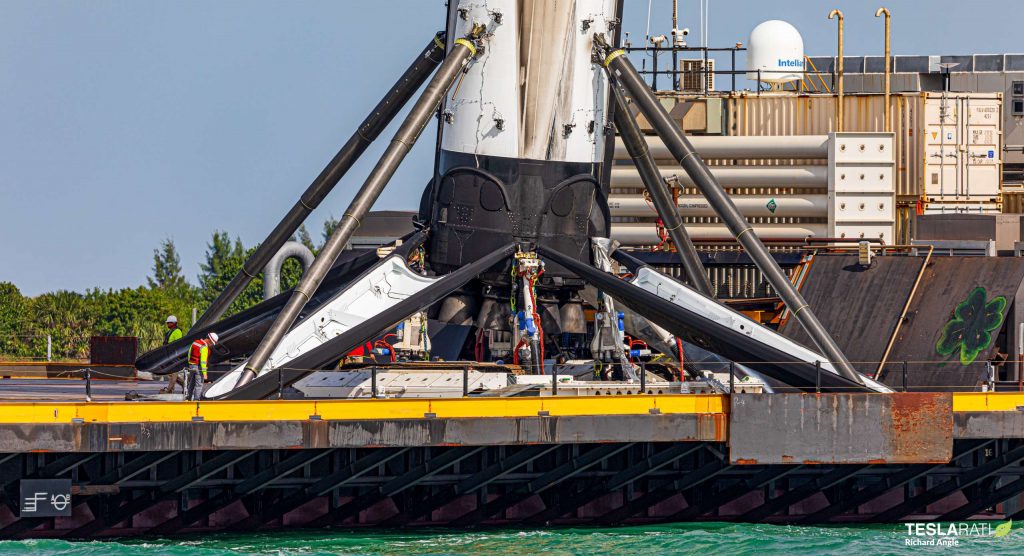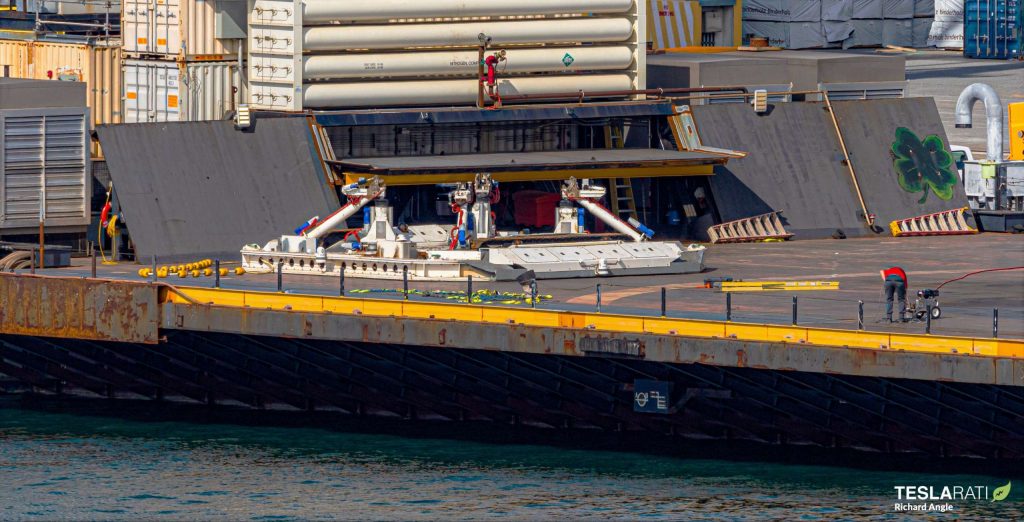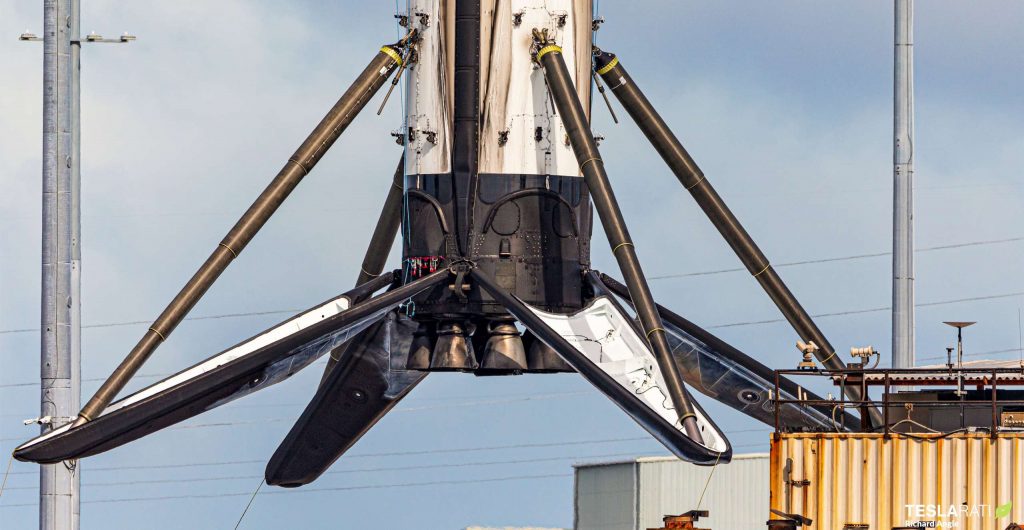

News
SpaceX’s most important Falcon 9 booster yet returns to port with a lean
On November 19th, what is likely SpaceX’s most important Falcon 9 booster yet returned to Port Canaveral with a surprise – perhaps the most dramatic lean ever observed on one of the recovered rockets.
Tilted a solid 10+ degrees from vertical, the lean was immediately visible as soon as the top of the rocket crest the horizon, and it later became clear that one of Falcon 9 booster B1061’s four landing legs had no contact at all with drone ship Just Read The Instruction’s (JRTI) deck. Four days prior, Falcon 9 (and B1061) became the first commercially-developed rocket in history to be certified to launch NASA astronauts, a feat it pulled off flawlessly. Crew Dragon safely delivered four astronauts to the International Space Station on November 16th, marking the culmination of more than half a decade of (mostly) uninterrupted work.
Even before Crew Dragon and Falcon 9’s momentous Crew-1 launch, though, NASA had already revealed some details that would make parts of Crew-1 even more important and the follow-up Crew-2 launch – scheduled as early as March 2021 – perhaps the most significant mission in SpaceX’s history.


In short, less than a month after SpaceX’s equally flawless Crew Dragon Demo-2 astronaut launch debut, NASA contract modifications revealed that the agency had permitted SpaceX to reuse both Dragon capsules and Falcon 9 boosters on upcoming astronaut launches.
“In a wholly unexpected turn of events, a modification to SpaceX’s ~$3.1 billion NASA Commercial Crew Program (CCP) contract was spotted on June 3rd. Without leaving much room for interpretation, the contract tweak states that SpaceX is now “[allowed to reuse] the Falcon 9 launch vehicle and Crew Dragon spacecraft beginning with” its second operational astronaut launch, known as Post Certification Mission-2 (PCM-2) or Crew-2.”
Teslarati.com — June 9th, 2020

A few short months after that discovery, NASA itself specifically announced that it had given SpaceX the go-ahead to reuse Demo-2 Crew Dragon capsule C206 and Crew-1 Falcon 9 booster B1061 on Crew-2, the company’s second operational astronaut launch. Scheduled no earlier than March 31st, 2021, Crew-2 will most likely launch before the Crew-1 Crew Dragon departs the space station and returns its four crew members to Earth, a milestone expected sometime in April.
For almost anyone who has followed NASA’s Commercial Crew Program (CCP) and its attitude towards SpaceX’s reusability efforts from the beginning, the space agency’s rapid willingness to trust its most important cargo – humans – to flight-proven Dragons and Falcon 9 boosters came as a huge surprise. If SpaceX is able to reuse both capsule C206 and booster B1061 as planned, Crew-2 will without a doubt be the most significant milestone in commercial spaceflight history, simultaneously proving that astronauts can be safely launched on commercial flight-proven rockets and spacecraft.



Of course, while Demo-2 Crew Dragon capsule C206 may have already been successfully recovered, SpaceX still had to land Falcon 9 booster B1061 and safely return it to port after Crew-1 before it could consider reusing it on Crew-2. Based on the rocket’s appearance upon its arrival at Port Canaveral, B1061 had an extremely close call. With what can be intuited from observation alone, it appears that sometime after B1061 landed and before the drone ship’s tank-like ‘Octagrabber’ robot could secure the booster, a stray swell or sudden burst of high seas must have bucked Just Read The Instructions about, causing B1061 to slide around on the slippery deck.
That would explain why the Falcon 9 first stage arrived in port on one of the far corners of drone ship JRTI – also sign that B1061 likely hit the yellow barrier included specifically to prevent boosters from sliding off drone ship decks. At the same time, B1061 must have had a moderately rough landing, causing at least one of its four legs to expend a large portion of a single-use shock absorber called a “crush core,” leaving the booster sitting at an angle. Based on photos of the arrival, that tilt likely left JRTI’s Octagrabber unable to latch onto all four of Falcon 9’s hold-down clamps, forcing recovery technicians to improvise and manually chain the rocket to the deck where the robotic solution fell short.


Thankfully, the SpaceX recovery team’s apparent heroics and luck proved to be enough and the sturdy Falcon 9 booster was returned to dry land without issue, lifted off of JRTI’s deck around 24 hours after arriving in port. Based on photos of the crush cores at the bottom tip of each leg, B1061’s rough landing and eventful journey was fairly mild as far as they come and, as CEO Elon Musk notes, crush core replacement is likely all that’s needed to make the rocket good as new.
Had B1061 been lost at sea, Crew-2 would have almost certainly been delayed to give SpaceX enough time to come up with an entirely new Falcon 9 first stage. Luckily for SpaceX, that didn’t happen and the company’s plans to launch astronauts on the flight-proven booster are still in play.
Elon Musk
Why Tesla’s Q3 could be one of its biggest quarters in history
Tesla could stand to benefit from the removal of the $7,500 EV tax credit at the end of Q3.

Tesla has gotten off to a slow start in 2025, as the first half of the year has not been one to remember from a delivery perspective.
However, Q3 could end up being one of the best the company has had in history, with the United States potentially being a major contributor to what might reverse a slow start to the year.
Earlier today, the United States’ House of Representatives officially passed President Trump’s “Big Beautiful Bill,” after it made its way through the Senate earlier this week. The bill will head to President Trump, as he looks to sign it before his July 4 deadline.
The Bill will effectively bring closure to the $7,500 EV tax credit, which will end on September 30, 2025. This means, over the next three months in the United States, those who are looking to buy an EV will have their last chance to take advantage of the credit. EVs will then be, for most people, $7,500 more expensive, in essence.
The tax credit is available to any single filer who makes under $150,000 per year, $225,000 a year to a head of household, and $300,000 to couples filing jointly.
Ending the tax credit was expected with the Trump administration, as his policies have leaned significantly toward reliance on fossil fuels, ending what he calls an “EV mandate.” He has used this phrase several times in disagreements with Tesla CEO Elon Musk.
Nevertheless, those who have been on the fence about buying a Tesla, or any EV, for that matter, will have some decisions to make in the next three months. While all companies will stand to benefit from this time crunch, Tesla could be the true winner because of its sheer volume.
If things are done correctly, meaning if Tesla can also offer incentives like 0% APR, special pricing on leasing or financing, or other advantages (like free Red, White, and Blue for a short period of time in celebration of Independence Day), it could see some real volume in sales this quarter.
You can now buy a Tesla in Red, White, and Blue for free until July 14 https://t.co/iAwhaRFOH0
— TESLARATI (@Teslarati) July 3, 2025
Tesla is just a shade under 721,000 deliveries for the year, so it’s on pace for roughly 1.4 million for 2025. This would be a decrease from the 1.8 million cars it delivered in each of the last two years. Traditionally, the second half of the year has produced Tesla’s strongest quarters. Its top three quarters in terms of deliveries are Q4 2024 with 495,570 vehicles, Q4 2023 with 484,507 vehicles, and Q3 2024 with 462,890 vehicles.
Elon Musk
Tesla Full Self-Driving testing continues European expansion: here’s where
Tesla has launched Full Self-Driving testing in a fifth European country ahead of its launch.

Tesla Full Self-Driving is being tested in several countries across Europe as the company prepares to launch its driver assistance suite on the continent.
The company is still working through the regulatory hurdles with the European Union. They are plentiful and difficult to navigate, but Tesla is still making progress as its testing of FSD continues to expand.
Today, it officially began testing in a new country, as more regions open their doors to Tesla. Many owners and potential customers in Europe are awaiting its launch.
On Thursday, Tesla officially confirmed that Full Self-Driving testing is underway in Spain, as the company shared an extensive video of a trip through the streets of Madrid:
Como pez en el agua …
FSD Supervised testing in Madrid, Spain
Pending regulatory approval pic.twitter.com/txTgoWseuA
— Tesla Europe & Middle East (@teslaeurope) July 3, 2025
The launch of Full Self-Driving testing in Spain marks the fifth country in which Tesla has started assessing the suite’s performance in the European market.
Across the past several months, Tesla has been expanding the scope of countries where Full Self-Driving is being tested. It has already made it to Italy, France, the Netherlands, and Germany previously.
Tesla has already filed applications to have Full Self-Driving (Supervised) launched across the European Union, but CEO Elon Musk has indicated that this particular step has been the delay in the official launch of the suite thus far.
In mid-June, Musk revealed the frustrations Tesla has felt during its efforts to launch its Full Self-Driving (Supervised) suite in Europe, stating that the holdup can be attributed to authorities in various countries, as well as the EU as a whole:
Tesla Full Self-Driving’s European launch frustrations revealed by Elon Musk
“Waiting for Dutch authorities and then the EU to approve. Very frustrating and hurts the safety of people in Europe, as driving with advanced Autopilot on results in four times fewer injuries! Please ask your governing authorities to accelerate making Tesla safer in Europe.”
Waiting for Dutch authorities and then the EU to approve.
Very frustrating and hurts the safety of people in Europe, as driving with advanced Autopilot on results in four times fewer injuries!
Please ask your governing authorities to accelerate making Tesla safer in Europe. https://t.co/QIYCXhhaQp
— Elon Musk (@elonmusk) June 11, 2025
Tesla said last year that it planned to launch Full Self-Driving in Europe in 2025.
Elon Musk
xAI’s Memphis data center receives air permit despite community criticism
xAI welcomed the development in a post on its official xAI Memphis account on X.

Elon Musk’s artificial intelligence startup xAI has secured an air permit from Memphis health officials for its data center project, despite critics’ opposition and pending legal action. The Shelby County Health Department approved the permit this week, allowing xAI to operate 15 mobile gas turbines at its facility.
Air permit granted
The air permit comes after months of protests from Memphis residents and environmental justice advocates, who alleged that xAI violated the Clean Air Act by operating gas turbines without prior approval, as per a report from WIRED.
The Southern Environmental Law Center (SELC) and the NAACP has claimed that xAI installed dozens of gas turbines at its new data campus without acquiring the mandatory Prevention of Significant Deterioration (PSD) permit required for large-scale emission sources.
Local officials previously stated the turbines were considered “temporary” and thus not subject to stricter permitting. xAI applied for an air permit in January 2025, and in June, Memphis Mayor Paul Young acknowledged that the company was operating 21 turbines. SELC, however, has claimed that aerial footage shows the number may be as high as 35.
Critics are not giving up
Civil rights groups have stated that they intend to move forward with legal action. “xAI’s decision to install and operate dozens of polluting gas turbines without any permits or public oversight is a clear violation of the Clean Air Act,” said Patrick Anderson, senior attorney at SELC.
“Over the last year, these turbines have pumped out pollution that threatens the health of Memphis families. This notice paves the way for a lawsuit that can hold xAI accountable for its unlawful refusal to get permits for its gas turbines,” he added.
Sharon Wilson, a certified optical gas imaging thermographer, also described the emissions cloud in Memphis as notable. “I expected to see the typical power plant type of pollution that I see. What I saw was way worse than what I expected,” she said.
-

 Elon Musk3 days ago
Elon Musk3 days agoTesla investors will be shocked by Jim Cramer’s latest assessment
-

 News1 week ago
News1 week agoTesla Robotaxi’s biggest challenge seems to be this one thing
-

 News2 weeks ago
News2 weeks agoTexas lawmakers urge Tesla to delay Austin robotaxi launch to September
-

 Elon Musk2 weeks ago
Elon Musk2 weeks agoFirst Look at Tesla’s Robotaxi App: features, design, and more
-

 Elon Musk2 weeks ago
Elon Musk2 weeks agoxAI’s Grok 3 partners with Oracle Cloud for corporate AI innovation
-

 News2 weeks ago
News2 weeks agoSpaceX and Elon Musk share insights on Starship Ship 36’s RUD
-

 News2 weeks ago
News2 weeks agoWatch Tesla’s first driverless public Robotaxi rides in Texas
-

 News2 weeks ago
News2 weeks agoTesla has started rolling out initial round of Robotaxi invites

















